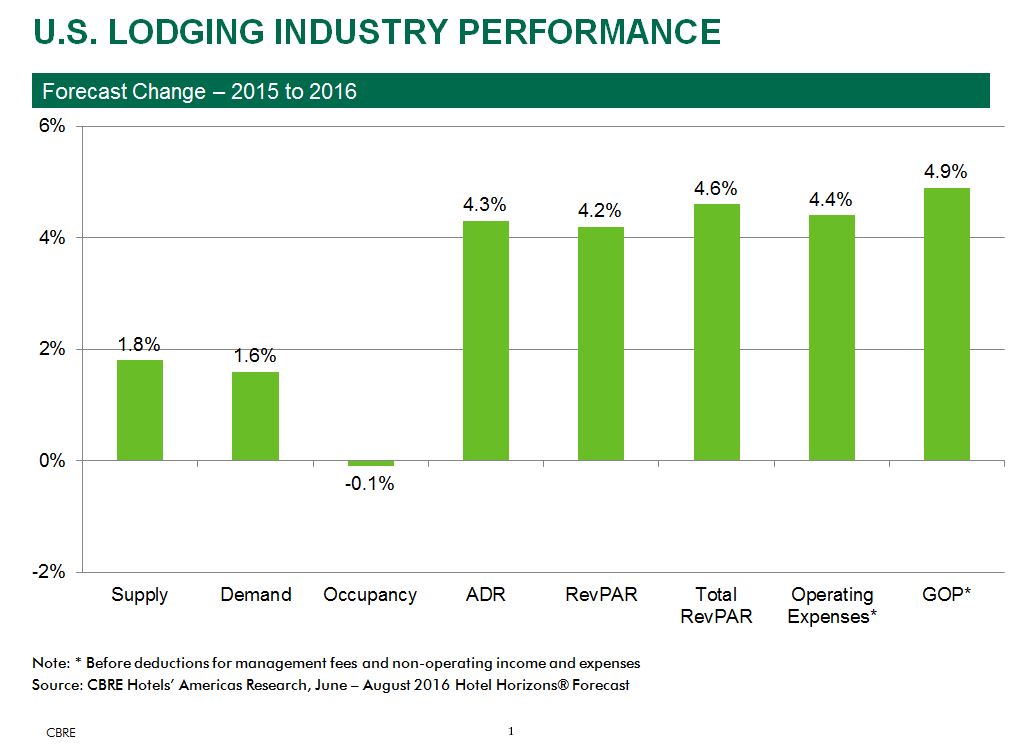U.S. Lodging Market Forecast To Grow, But At Slower Pace
Atlanta – June 6, 2016 – The U.S. hotel market suffered a 0.5 percent decline in occupancy during the first quarter of 2016. This is the first year-over-year decline in occupancy since the fourth quarter of 2009 according to STR.
Based upon the recently released June 2016 edition of Hotel Horizons®, the annual occupancy rate for U.S. hotels is forecast to decline in both 2016 and 2017, the result of supply increases outpacing growth in demand. U.S. occupancy levels will persist above the 65 percent mark, thus providing pricing leverage for hotel operators. For 2016, average daily room rates (ADR) are projected to increase by 4.3 percent, followed by a 4.9 boost in 2017. The gains in ADR will offset the declines in occupancy, thus resulting in revenue (RevPAR) gains of 4.2 and 4.7 percent the next two years.
“The first quarter decline in occupancy is a concern for U.S. hotel owners and operators,” said R. Mark Woodworth, senior managing director of CBRE Hotels’ Americas Research. “The industry has been on a good run for the past five years, and there were no obvious economic warning signs foreshadowing a decline in occupancy. That being said, the slight pull-back from the record occupancy level achieved in 2015 is not particularly surprising.”
The cause of the decline in occupancy was a 1.5 percent increase in supply, accompanied by an increase in demand of just 1.0 percent. “It is important to note that U.S. lodging demand did grow during the first quarter of 2016. While ADR increases are starting to mute demand growth, the economy remains healthy and will generate increases in lodging demand for the foreseeable future. We are simply at that point in the cycle when supply growth is outstripping demand,” Woodworth noted.
“Compared to the 6.0 to 8.0 percent annual increases in RevPAR the industry has enjoyed the past five years, our forecasts of RevPAR growth for the next two years seem quite modest. However, we are still projecting growth in RevPAR, and in real terms, revenue gains will occur at more than twice the pace of inflation,” Woodworth added.
Deceleration
“Lodging is a cyclical industry. The pace of RevPAR growth seen during the recovery phase of the cycle cannot be sustained forever,” said John B. (Jack) Corgel, Ph.D., professor of real estate at the Cornell University School of Hotel Administration and senior advisor to CBRE Hotels’ Americas Research. “The deceleration in RevPAR growth is a natural economic occurrence as the market operates at the top of the cycle.”
Concurrent with the deceleration of industry performance, CBRE Hotels’ Americas Research has adjusted its forecast for 2016 downward. The current RevPAR change forecast of 4.2 percent for 2016 is down 130 basis points from our March 2016 projections. Half of the reduced forecast can be attributed to the contraction that has already taken place during the first quarter, while the remaining adjustment was triggered by the persistence of low inflation.
“Given the outlook for business and consumer expenditures throughout the remainder of the year, our projections for demand growth during the final three quarters actually are slightly greater than what we were envisaging three months ago,” Corgel stated. “What has changed is our outlook for ADR. Low inflation, new competition in select markets, and enhanced consumer empowerment created by technology and the sharing economy have contributed to a reduction in our forecast for ADR.”
Natural Supply
After achieving all-time record levels of occupancy, the industry is attracting the attention of developers who have been sitting on the sidelines for an extended period of time. The latest edition of Hotel Horizons® forecasts the nationwide supply growth rate will surpass the long-run annual average rate of 1.9 percent in 2017.
The declines in occupancy that are contributing to the deceleration cleary are attributable to changes in supply. The five U.S. lodging markets forecast to see the greatest declines in occupancy in 2016 simultaneously will average a 6.3 percent increase in supply during the year. Concurrently, upscale hotels are forecast to experience the greatest decline in occupancy among all the chain-scales primarily because of the 5.3 percent increase in competitive rooms.
“Supply growth is occurring, but our projections do not approach the historical levels of new construction activity observed in the late 1980s, 1990s and 2000s. We do not foresee a supply-driven industry downturn,” Woodworth predicted.
“The industry has passed the uphill recovery phase of the cycle, and we are now in a prolonged period at the top. Looking forward two to three years, we do not see any reason why U.S. hotels should not continue to enjoy gains on both the top and bottom lines, albeit at a more modest pace compared to the past two or three years,” Woodworth concluded.
To purchase copies of the June 2016 editions of Hotel Horizons® for the U.S. lodging industry and 60 major markets, please visit: https://pip.cbrehotels.com
CBRE Hotels is a specialized advisory group within CBRE providing brokerage, valuation, consulting, research and capital markets services to companies in the hotel sector. CBRE Hotels is comprised of more than 375 dedicated hospitality professionals located in 60 offices across the globe.




